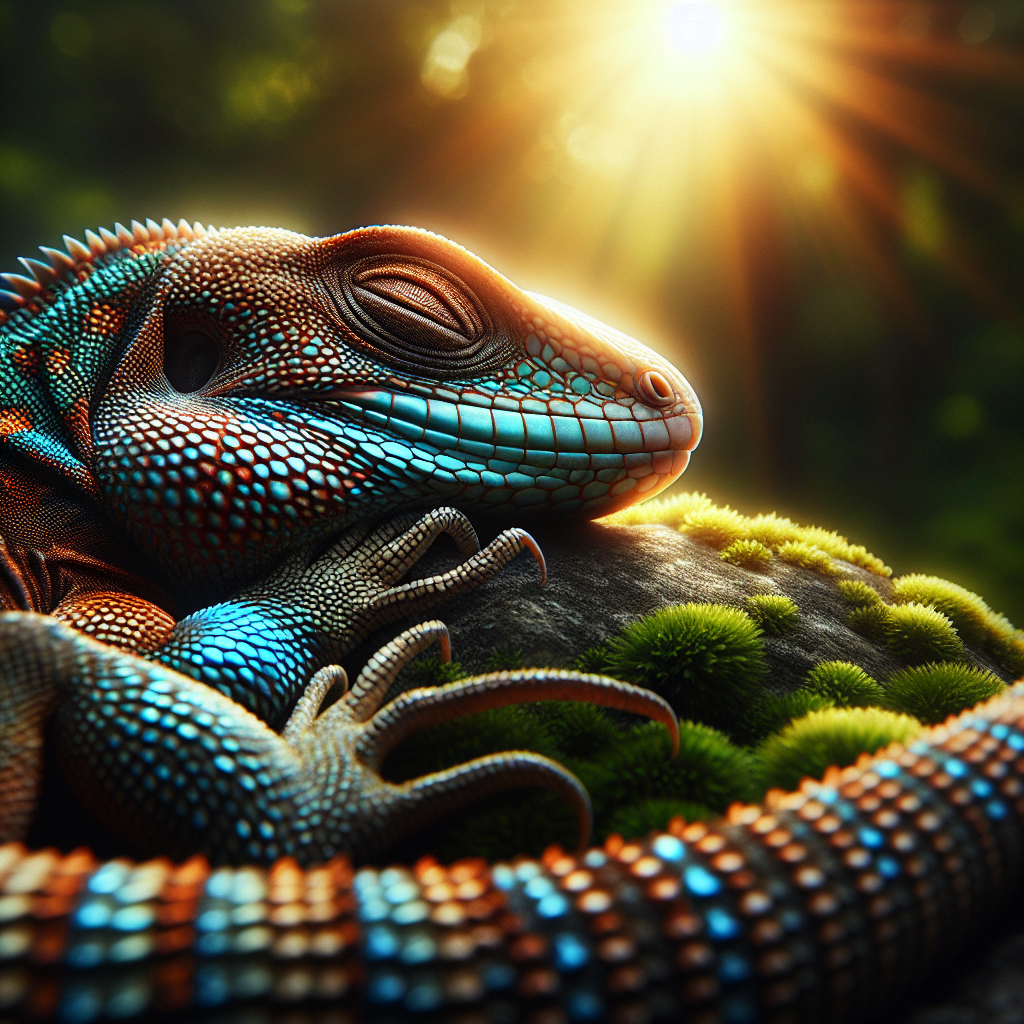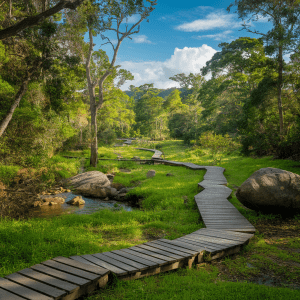Introduction: Understanding Lizard Sleep Patterns
Have you ever wondered about the fascinating world of lizard sleep patterns? Let me enlighten you on this intriguing topic. Picture this: a tiny gecko nestled in a cozy corner, eyes closed in peaceful slumber. It’s a sight to behold, isn’t it? But did you know that not all lizards sleep the same way? Some bask in the sun during the day, while others are nocturnal creatures, prowling under the cover of darkness. Understanding their sleep patterns can offer valuable insights into their behavior and well-being. Imagine being able to decode the secrets of these ancient reptiles through their sleeping habits. By observing their slumber routines, we can gain a deeper appreciation for the unique world of lizards. So, the next time you see a lizard lounging lazily in the sun, take a moment to ponder its sleep patterns and what they might reveal. Join me on this enchanting journey into the mysterious realm of lizard sleep patterns, where every snooze tells a story waiting to be unraveled.
Importance of Studying Lizard Sleep Behavior
II. Importance of Studying Lizard Sleep Behavior
Understanding the sleep behavior of lizards may seem trivial at first glance. Yet, the intricacies of how these fascinating creatures rest can unlock a treasure trove of knowledge. Imagine being a detective, unraveling the mystery of sleep in a whole new realm – the world of lizards. Each lizard’s sleep pattern is like a unique puzzle piece waiting to be discovered. By studying their slumber, we gain insights into their overall well-being, health, and behavior. It’s not just about observing a lizard snooze; it’s about delving deeper into their world and understanding what makes them tick, or rather, sleep. Did you know that some lizards enter a state of torpor during colder months, slowing down their metabolism to conserve energy? This adaptive behavior showcases the remarkable ways in which lizards have evolved to survive in diverse environments. As we delve into the complexities of lizard sleep patterns, we begin to appreciate the interconnectedness of all living beings on our planet. So, let’s embark on this journey together, exploring the hidden world of lizard sleep and discovering the wonders that lie beneath their closed eyelids. Let’s dive into the realm of lizard slumber and awaken our curiosity to unravel the secrets of their nocturnal adventures.
Factors Influencing Lizard Sleep Patterns
Have you ever wondered what factors influence the sleep patterns of our scaly friends, the lizards? Well, let me tell you, it’s a fascinating subject that goes beyond just the basic need for rest. These creatures have their own unique rhythm when it comes to catching some Z’s.
Picture this: a lizard basking in the sun, soaking up the warmth to regulate its body temperature before finding a cozy spot to curl up and drift off to dreamland. These cold-blooded creatures have a whole different approach to sleep compared to us warm-blooded mammals.
One interesting fact about lizard sleep patterns is that they are often influenced by environmental cues. From the amount of sunlight they receive to the temperature of their surroundings, these factors can play a significant role in when and how long lizards sleep.
Imagine trying to sleep with a constantly changing environment – it’s no easy feat! That’s why creating a stable and comfortable sleeping environment for your pet lizard is crucial for their well-being. Providing a suitable habitat with proper lighting, temperature, and hiding spots can help mimic their natural sleep patterns.
So, next time you see your lizard taking a snooze, take a moment to appreciate the intricate dance of factors that shape their sleep patterns. It’s a delicate balance between nature and nurture that keeps these fascinating creatures well-rested and ready to tackle the day ahead.
Common Lizard Sleeping Habits
Have you ever observed your lizard’s sleeping habits and wondered what’s going on in their tiny reptilian brains? It’s fascinating to think about how these creatures, with their scaly skin and beady eyes, manage to catch some z’s in their unique way.
When it comes to lizard sleep patterns, you might be surprised to learn that these creatures have some pretty interesting habits. For example, did you know that some lizards are diurnal, meaning they are most active during the day, while others are nocturnal, preferring to hunt and explore under the cover of darkness? It’s like having a miniature detective roaming your terrarium!
Understanding your lizard’s sleep behavior can provide valuable insights into their overall health and well-being. By observing when and where your lizard sleeps, you can ensure that their habitat is conducive to a good night’s rest. Just imagine your lizard curling up in its favorite spot, dreaming of catching crickets or basking in the sun.
Creating a suitable sleeping environment for your lizard is essential for their happiness and longevity. From providing the right temperature and lighting to offering hiding spots for a sense of security, there are many ways you can enhance your lizard’s sleep quality. It’s like setting the stage for a blockbuster lizard siesta!
So, the next time you catch your lizard napping under a warm lamp or nestled in a cozy corner, take a moment to appreciate their unique sleep patterns and how they contribute to their overall well-being. After all, a well-rested lizard is a happy lizard!
How to Create a Suitable Sleeping Environment for Lizards
Have you ever wondered why lizards have such unique sleeping habits compared to other animals? Let’s delve into the fascinating world of lizard sleep patterns.
When it comes to observing lizards at rest, you might be surprised by the variety of positions and locations they choose. From hanging upside down on branches to burrowing deep into the ground, these creatures have some quirky bedtime routines.
One interesting fact about lizard sleep is that some species are capable of sleeping with one eye open. It’s not just a saying – it’s a reality for these vigilant reptiles who need to stay alert even while catching some Z’s.
Understanding lizard sleep behavior is not just about curiosity; it can also provide valuable insights into their overall health and well-being. By monitoring their sleep patterns, we can identify any potential issues or stressors that may be affecting them.
So, the next time you catch your pet lizard snoozing in an unusual position, take a moment to appreciate the complexity of their slumber. It’s not just about getting some shut-eye; it’s a window into their world that can teach us so much more than meets the eye.
Observing and Documenting Lizard Sleep Patterns
Are you ready to dive into the intriguing world of lizard sleep patterns? Let’s uncover some fascinating secrets! Picture this: a tiny lizard nestled in its cozy habitat, eyes closed in peaceful slumber. Did you know that some lizard species can even dream during their sleep cycles? Imagine the adventures playing out in their minds! When observing lizard sleep patterns, you might encounter some challenges. These elusive creatures have their own unique ways of dozing off. But fear not, with patience and keen observation, you’ll unlock the mysteries of their nocturnal activities. Have you ever wondered how the environment impacts a lizard’s sleep quality? From temperature to lighting, every detail plays a crucial role in ensuring their restful slumber. So, how can you create the perfect sleeping haven for your scaly friends? Stay tuned as we delve deeper into the art of providing optimal sleeping conditions for these fascinating creatures. By understanding and respecting their sleep patterns, you not only enhance their well-being but also deepen your connection with the enchanting world of lizards. So, are you ready to embark on this enlightening journey into the realm of lizard sleep habits? Let’s explore together!
Benefits of Understanding Lizard Sleep Cycles
Have you ever wondered why understanding lizard sleep cycles matters? It’s not just about their slumber; it’s like peeking into their secret world, a world where rest isn’t just about closing their eyes but a crucial part of their survival.
Picture this: a little lizard basking under the warm sun, the epitome of relaxation. But what goes on when they drift off into dreamland? That’s where things get interesting. By unraveling the mysteries of their sleep patterns, we gain a deeper insight into their overall well-being.
Imagine being able to decode why a lizard sleeps longer on some days than others. It’s like solving a puzzle, each piece revealing a new facet of their behavior. And with this knowledge, we can tailor their environment to ensure they get the quality sleep they need.
Think about it – by understanding how sleep impacts a lizard’s health, we’re not just caring for them; we’re becoming their sleep advocates. We hold the key to enhancing their lives and creating a harmonious balance in their world. The more we delve into their sleep habits, the more we uncover the intricate tapestry of their existence. So, are you ready to embark on this captivating journey of discovery with me?
Tips for Improving Lizard Sleep Quality
Let’s dive into the realm of lizard sleep quality – a crucial aspect often overlooked by many reptile enthusiasts. Picture this: you’ve meticulously set up your terrarium, creating a cozy haven for your scaly friend to rest and rejuvenate. But have you ever pondered if your lizard is truly getting the beauty sleep it deserves? Here’s where things get intriguing. Lizards, much like us, need adequate and uninterrupted sleep to thrive. Imagine a day without your usual slumber – groggy, irritable, and far from your best self. It’s no different for these fascinating creatures. Providing a conducive sleep environment isn’t just about having a plush bed; it’s about mimicking their natural habitat and ensuring they feel safe and secure. So, how can you enhance your lizard’s sleep quality? One practical tip is to maintain a consistent day-night cycle, allowing your pet to establish a regular sleep pattern. Imagine the wonders a good night’s sleep can do for your lizard’s overall well-being. By delving deeper into the world of lizard sleep patterns, you’re not just ensuring their health – you’re also fostering a stronger bond with your scaly companion. So, let’s embark on this journey together and unlock the secrets to blissful lizard slumber!
Impact of Sleep Deprivation on Lizard Health
Have you ever wondered how sleep deprivation affects lizards? Well, let me tell you, it’s no joke!
Lizards, like humans, need their beauty rest to function at their best. Think about a night when you couldn’t catch any Z’s – you probably felt groggy, irritable, and far from your usual self. Now, imagine feeling like that all the time – that’s what sleep-deprived lizards go through.
When lizards don’t get enough shut-eye, their health takes a hit. Just like us, their immune systems weaken, making them more susceptible to illnesses. Not to mention, their cognitive abilities and overall well-being suffer too.
Now, picture this: a sleep-deprived lizard trying to catch its prey – not the most graceful sight, right? It’s like watching a clumsy dancer trying to perform a complex routine. Lizards need their sleep to stay sharp and agile.
So, what can we do to help our scaly friends get the rest they need? Creating a cozy and comfortable sleeping environment is key. Just like how you have your favorite pillow and blanket, lizards have their preferences too.
Think about it – would you want to be constantly disturbed while trying to snooze? Of course not! Lizards are no different. By respecting their need for sleep, we can ensure they live happy and healthy lives.
Remember, a well-rested lizard is a happy lizard!
Conclusion: Enhancing Your Knowledge of Lizard Sleep Patterns
Have you ever wondered about the fascinating world of lizard sleep patterns? Let me shed some light on this intriguing topic.
Lizards may seem like simple creatures, but their sleep behaviors are surprisingly complex and diverse. From basking in the sun to hiding in burrows, these reptiles have unique ways of catching their Z’s.
One interesting fact about lizard sleep is that different species have varying patterns. Some lizards are nocturnal, while others are diurnal, meaning they are active during the day. Understanding these patterns can provide valuable insights into their natural behaviors.
Observing lizard sleep can be a rewarding experience. Imagine quietly watching a lizard curl up in its favorite spot, eyes closed in peaceful slumber. It’s a reminder of the beauty and diversity of the animal kingdom.
Creating a comfortable environment for your pet lizard is essential for promoting healthy sleep. Providing proper lighting, temperature, and hiding spots can help mimic their natural habitat and ensure they get the rest they need.
So, the next time you see a lizard soaking up the sun or burrowed in the sand, take a moment to appreciate the wonder of their sleep patterns. Who knew that these seemingly simple creatures could have such fascinating bedtime routines?




